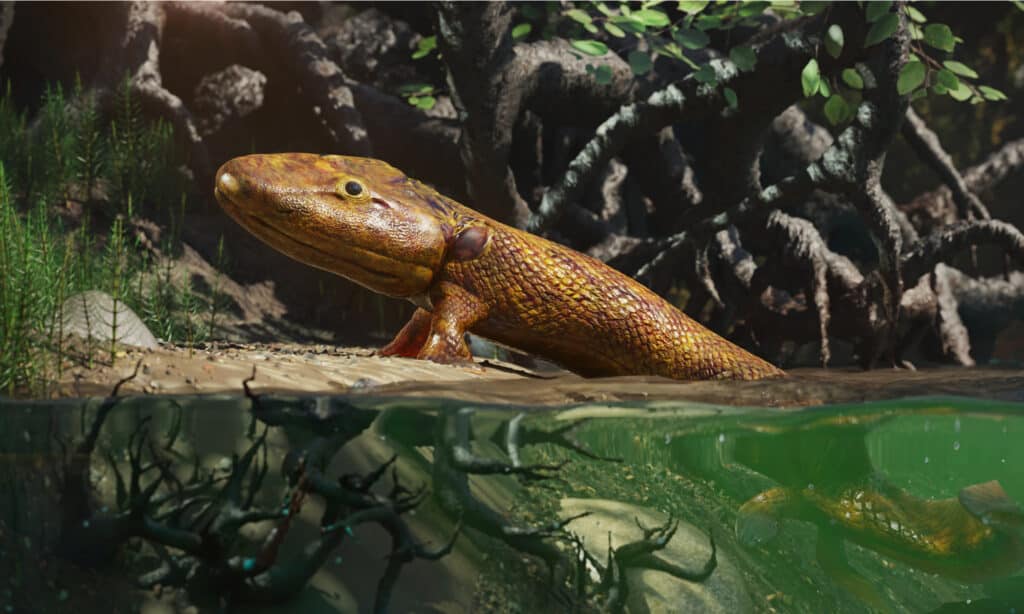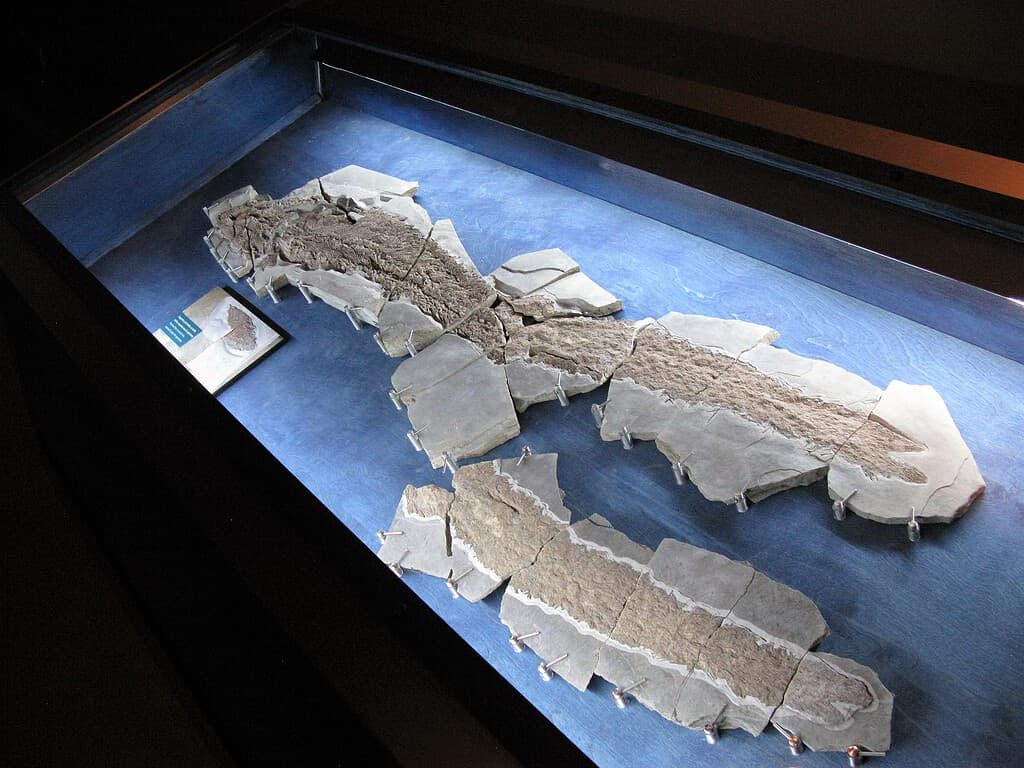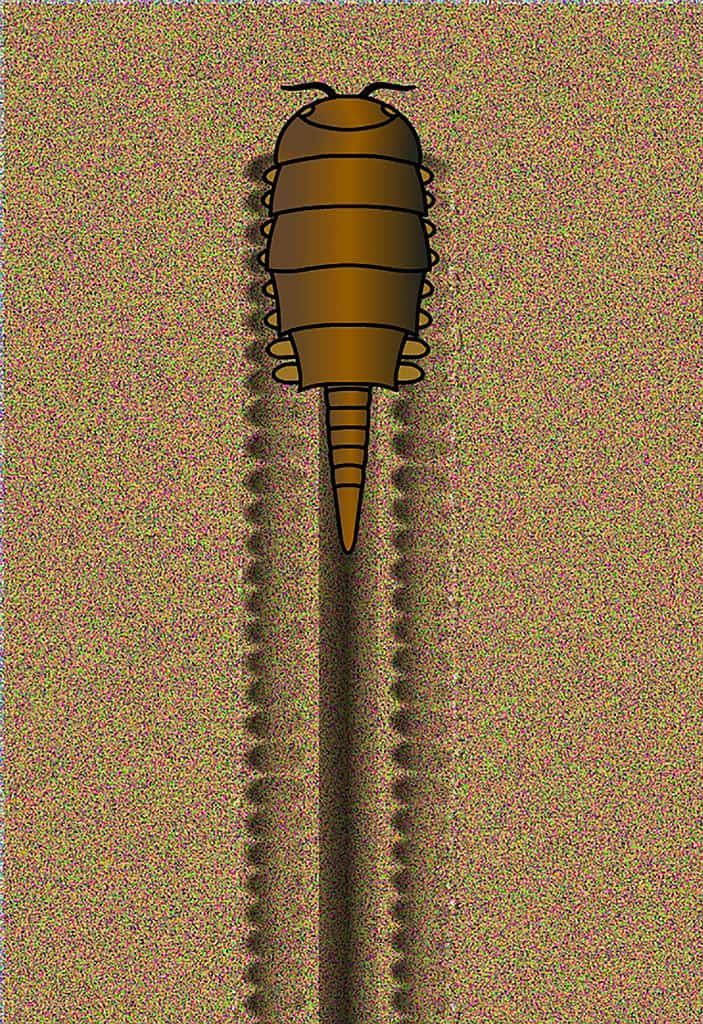While a lot of people think evolution happened in a straight line, it didn’t. The path from a single-celled organism to human beings is a complicated bush full of twists and turns. However, at one point, something decided to leave the water for the first time since all life originated in the oceans. What are 7 land animals among the first to ever walk the Earth?
7. Ichthyostega: 370 Million Years Old

had primitive limbs and probably moved awkwardly like a seal on land.
©Dr. Günter Bechly, CC BY-SA 3.0 <https://creativecommons.org/licenses/by-sa/3.0>, via Wikimedia Commons – License
During the Paleozoic era, there were periods of intense wetness and dryness. As a result, Ichthyostega evolved in a way that allowed it to survive in both extremes. They probably moved a lot like mudskipper fish do today by hobbling around on just their front extremities.
Ichthyostega fossils were found in Greenland, and they’re some of the earliest to show the ability to bear weight on primitive limbs. 4 separate species of Ichthyostega were discovered in the 1930s with additional examples being collected in the 1950s.
These animals had lungs and probably used their limbs mostly to move around swamps. While they did come up on shore, they probably were awkward like seals instead of stealthy like today’s amphibians. In addition to lungs, they also had gills which they relied on to release carbon dioxide.
This animal had 7 fingerlike bones inside its back appendages. These appendages weren’t fins anymore and acted more like paddles. Its tail fin was used for swimming, but it wasn’t as useful as the tail fins on similar animals that hadn’t yet adapted for terrestrial escapades.
Ichthyostega had a large pelvic girdle in comparison to its fully aquatic contemporaries. This gave it some of the strength needed to move around on land. Its backbone was also stronger than comparable animals which allowed it more mobility out of the water.
6. Tiktaalik roseae: 375 Million Years Old

As one of the earliest known terrestrial vertebrates,
Tiktaalikis a blend of aquatic and terrestrial features.
©Dotted Yeti/Shutterstock.com
Tiktaalik roseae is one of the earliest terrestrial vertebrates. This has been deduced from the augmented pelvic fin bones found in its fossils. While it doesn’t have a true pelvis that can support much body weight, it does show that evolution toward the use of hind legs for movement was underway.
Tiktaalik is famous for being the perfect blend of aquatic and terrestrial animals by showing the moment when feet came from fins. While it still had fin rays that leaned toward being a fish, it had land animal-like wrist joints. It also had ears that heard well both in the water and on land.
5. Elpistostege watsoni: 380 Million Years Old

probably didn’t spend a lot of time on land.
©Placoderm2, CC BY-SA 4.0 , via Wikimedia Commons – License
From the Late Devonian Period, an Elpistostege watsoni fossil is a good example of fin rays with fingerlike bones. This specimen was discovered in Canada’s Miguasha National Park.
While this animal probably didn’t spend a lot of time out of the water, it was able to support itself in the shallowest of water and take short trips onto land. Its fingerlike bones meant weight was distributed just right within its fins so that Elpistostege was able to use them to move around.
Elpistostege had large pointy teeth that it used to eat fish. It was probably the biggest predator in shallow waters during its heyday.
4. Attercopus fimbriungus: 380 Million Years Old

is a precursor to spiders with a segmented tail like that of a whip
scorpion
.
©TefiM/iStock via Getty Images
Bug-like creatures left the oceans before anything resembling fish or frogs with limbs tried to crawl out of the water. One such animal is Attercopus fimbriungus.
Attercopus fimbriungus is a precursor to spiders that had a segmented tail structure that looked like that of a whip scorpion. It did not have spinnerets though it did create silk via open glands on its underside.
Fossils of this animal were found in New York at the Panther Mountain Formation. It probably didn’t make webs, but it most likely produced silk for egg wrappings, to create walls for its burrows, or to create draglines used to escape predators.
3. Palaeocharinus: 410 Million Years Old

One of the oldest arthropods to live on land was
Palaeocharinus rhyniensis.
©Junnn11, CC BY-SA 4.0 , via Wikimedia Commons – License
Palaeocharinus are ancestors of spiders represented by 6 species identified in Scotland in 1923. These are among some of the oldest arthropods living solely on land.
They were excellent predators that made their living eating other early landwalkers. Scientists have created a video of how this genus of animal walked using specimens held by the Natural History Museum in London.
2. Pneumodesmus newmani: 430 Million Years Old

The
Pneumodesmus newmanifossil from Scotland showed this animal breathed air.
©TefiM/iStock via Getty Images
Pneumodesmus newmani may have been one of the first animals to live on land full-time. It currently holds the Guinness World Record for being the oldest land animal.
This earliest walker was a myriapod that looked like a millipede. However, it’s not from the same branch of myriapods from which modern millipedes descend.
It left a fossil showing that it breathed air. There is only one specimen measuring less than half of an inch long that is kept at the National Museum of Scotland in Edinburgh. This fossil was discovered in Stonehaven, Aberdeenshire, Scotland.
Scientists have gone back and forth about the age of Pneumodesmus newmani. It was originally believed to be about 428 million years old, but in 2017, someone postulated that it’s only 414 million years old. That was later refuted, and now the species is believed to be about 430 million years old.
1. Mosineia macnaughtoni: 500 Million Years Old

Mosineia macnaughtoni created the earliest known “footprints.”
©Kennethcgass, CC BY-SA 4.0 , via Wikimedia Commons – License
500 million years ago during the Cambrian Period, this arthropod left the earliest found footprints on the land. Mosineia macnaughtoni is one of the earliest examples of a Euthycarcinoidea. Also called Euthycarcinoids, these animals were arthropods with amphibious characteristics.
Their closest living relatives are most likely the myriapods which are millipedes and centipedes. Euthycarcinoids are probably the precursors to myriapods, hexapods, and crustaceans.
Mosineia macnaughtoni lived within tidal flats that existed in Wisconsin during its day. The representative fossils were found near the City of Mosinee.
It most likely exited the water to mate and eat. Its food source was probably microbial mats which covered most of the world’s beaches at the time.
The photo featured at the top of this post is © Placoderm2, CC BY-SA 4.0 , via Wikimedia Commons – License / Original
Thank you for reading! Have some feedback for us? Contact the AZ Animals editorial team.







